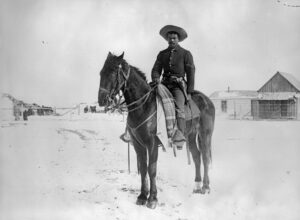Following the American Civil War, six all-Black infantry units spent time securing the American West, wrangling up thieves and chasing away Native Americans from their ancestral homes. The group came to be known as “buffalo soldiers,” a moniker given to them by Indigenous groups fighting for the federal government to honor its promises.
During their enlistment, the buffalo soldiers battled Native Americans dozens of times, generally winning the fights and quelling widespread unrest. As the original soldiers began to pass away, new all-Black regiments took their place, earning the buffalo soldier mantle. The last regiments were integrated in 1951 as the result of Executive Order 9981.
The buffalo soldier story reveals the hypocrisy of federal treatment of Black servicemembers – and the irony of their original purpose.
In the early days, just after the Civil War, the federal government marched the only all-Black regiments around the country to suppress valid Indigenous complaints. Such Indigenous complaints included matters involving land ownership and federal support. But the government pit one minority group against another, and worse yet, the buffalo soldiers still experienced discrimination and racism.
On three separate occasions from 1899 to 1917, Texans attacked the buffalo soldiers in larger racial disturbances. In addition to battling the uprisings that they were created to combat, they had to worry about the citizens near their posts. Take a second to fully appreciate the irony of this discrimination.
Black soldiers were ordered by a white government to suppress Indigenous grievances and almost everywhere they went, they were treated as non-citizens.
The irony of the buffalo soldier experience translated to numbers too. From 1866 to 1891, buffalo soldiers comprised 12% of the U.S. Army but were only awarded 4% of the Medals of Honor given out in that period. The truth then, is plain to see.
Our government took advantage of the first exclusively Black army units – a practice that remains in place to do this day.
Of course, there are no more segregated infantry regiments. But tales of racism towards Black servicemembers abound at West Point, overseas during active duty, and on our own shores. Retired Air Force Lt. Col. Stephanie Davis has recounted her colleagues labeling her an ABW, or angry Black woman, a racist stereotype. Deven Sherk, former staff sergeant in the U.S. Air Force, fell into depression and anxiety after his fellow servicemembers displayed a noose nearby and scrawled a swastika on the bathroom mirror.
Both of these issues, and the thousands more that we will never hear about, were brushed aside by superiors and ultimately ignored, akin to law enforcement standing behind officers who have committed fatal brutality. Until every one of these incidents is properly addressed, our government will continue to be one that doesn’t prioritize the welfare of minorities, even those that may sacrifice their lives.
Such mistreatment was on full display very recently. In a speech about how freed Black slaves were the first to honor fallen soldiers, sparking the tradition of Memorial Day, American Legion leaders cut the microphone of Army Lt. Col. Barnard Kemter. They censored his speech in real time in a ceremony with dozens of attendees. This is the sort of erasure faced by Black veterans and their history.
Saying the U.S. military shouldn’t be an instrument of social change is valid. But at least admit that the same military has is plagued by racism and has been for hundreds of years.

